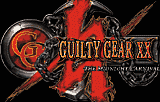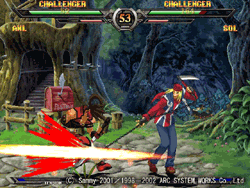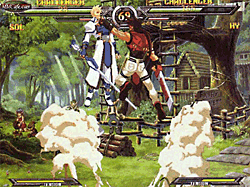Guilty Gear XX
It's probably illegal to start a review of a 2-D game released within the past five years without claiming '2-D gaming is a dying breed.' So: 2-D gaming is a dying breed being unfairly smothered under a mound of polygons. Never minding the fact that about 70% of the NES/NES library sucked thanks to the quantity over quality liscensed-title-producing Zerg Rush of Acclaim and others.
Guilty Gear XX is actually the third in a series of rather unique fighters, produced by the oft-maligned Sammy (The same people who brought us Amagon, Vice: Project Doom, and some forgettable brawlers.) But GGXX is nothing short of stellar as far as I'm concerned. I've played cynic for about a paragraph and a half, I think I'm entitled to gush for the rest of the piece.
First off, you can't play GGXX without first seeing the amazing visuals. All of the characters are presented as hi-resolution sprites- meaning they look more like animation cels than 'game characters.' The animation itself is still a few frames short of say, Mark of the Wolves quality, but the added quality more than makes up for it. The music shows some metal influence (as do the characters) and is fairly appropriate to each fighter.
The system is loaded down with gimmicks taken from almost every modern fighter- auto-combos, air dashing, air combos, so on. It's all pretty overwhelming to a novice, but experienced fighters will appreciate the balance of the system overall. Opponent blocking too much and keeping their distance? The Negative Penalty starts sapping their guard meter. Cornered? There are Bursts and Dead Angle moves that can push an opponent back and set them up for your next move. The Tension Meter is much more than a normal power bar as well- it steadily decreases if you don't stay active in the battle. The most famous gimmick in the Guilty Gear Arsenal, however, is the Instant Kill. As the name suggests, your fighter can, at any time, whip out a special move to finish off the opponent in one blow. Suprisingly, this doesn't unbalance gameplay as much as one would think- most Destruction Moves are very short range and have a noticable startup. Failure to hit with the kill removes that player's Tension Gauge for the rest of the match. And if they stay in Instant Kill mode too long, not only does the Tension Bar drop to zero, it starts eating away at their life bar. The new Gatling Combo system is reminiscent of the Real Bout Fatal Fury system in that sequential button presses create special combos. There are also Roman Cancels, but I'm not sure what that means. But hey, they named practically everything. With so many features, a button masher may manage to pull off some flashy maneuvers, but the game will be won by skill more often. The physics engine, oddly enough makes me think of platform games, with all the air jumping and easy-juggle moves. (By loose combos, I mean that you can continue a combination after your opponent slams into the ground as long as they bounce up a little on impact.)
One of the things I like best about Guilty Gear is oddly enough, the idea of a backstory that doesn't revolve around a tournament. Most of the time, anyway, as they allude to a tournament Ky Kiske won to join the Holy Knights. The story actually focuses on a group of various fortune hunters who clash with each other while chasing down a bounty. There was a similar approach in the Soul Edge/Calibur games, but the lure of cash attracts a wider variety of weirdos. Er, heroes. In the first game, the Gears (biological weapons) of Earth have come under the rule of a rogue command gear named Justice, who wants to kill everyone. After he is dispatched, things cool down until rumors begin to spread of a living and alledgedly peace-loving Gear named Dizzy. And XX picks up mere weeks after the conclusion of the previous game.
Sol Badguy is the ironically-named hero, the one we are to assume wins everything when regarding continuity, and is voiced by the game's creator himself. His rival is the squeaky-clean holy knight Ky Kiske. Most of the fighters in this game are returning favorites from GGX who are still feeling the impact of the battle with the bi (maybe tri)polar Dizzy. Sol spared her life and let Jam Kuradoberi (the token Chinese dress-sporting female martial artist) have the bounty to build a resaurant. But not everyone knows the bounty is off the "Innocent Gear's" head, and it seems darker forces (apparently the work of the enigmatic "That Man" who is referred to but never seen, and might as well be be the same That Man from Excel Saga) are on the move.
The characters are all pretty unique. Rock n' roll references abound, in character names as well as move names. At least half the cast seems to be on the schizo side as well, a prime example being the aforementioned half-Gear half-human Dizzy, who is herself mainly pacifist, but has a pair of living, arguing beings growing out of her back (!) that drive her to violence. A humorous undertone surrounds the subplot involving a search for survivors of destroyed Japan*- apparently they all have magic powers that the Holy Knights tried to neutralize. Baiken is a survivor of the genocide, a one-armed female samurai obsessed with revenge on Gears and their creator (yup, That Man.) Millia Rage, the cold woman who uses her hair as a weapon is involved in a sort of power struggle with Venom and Eddy (the fully possessed but essentially identical version of Zato-1/One from GGX) to overthrow the Assassin's Guild- a struggle that draws out Slayer, a new character and apparent head of the Guild. Also caught up in all of this are Axl Low, a time-displaced British punk from the 20th century (shades of Billy Kane?) and Anji Mito, an effeminite Japan survivor who might be from the (near)present as well. The newcomer Bridget is even more effeminate, however- 'he' appears to even a veteran player to be a cute girl with a yo-yo in a nun-type outfit. But he's actually a boy... which really creeps the hell out of me when he shoots the yoyo from between his legs, flips up his skirt, or so on. Do what I do and pretend Bridget is a girl, if you MUST use him. May is the cheery pirate girl who wields a giant anchor and is hopelessly in love with swinger Johnny, who is actually cool enough for me to not make fun of him for running a flying ship of underage girl pirates (which adds Dizzy to its roster at the end of GGX and welcomes Bridget by this game's end.) Also on the trend of possessed people, is the oddball Zappa. He's apparently possessed by the ghost of a jilted lover or something that makes him do weird things. To wrap up this incredibly long paragraph, Potemkin is the VERY LARGE muscle man with a heart of gold, Faust is a mad doctor whose fighting style is more evocative of Bugs Bunny than Bruce Lee, and the mysterious I-No is the guitar-riding witch of a final boss.
The story mode in GGXX is very well done, with branching stories that actually interconnect with the story modes of others rather nicely (again, not dissimilar from the Soul series Edgemaster/Mission Modes.) Though actual FMV is limited to the opening, the still portraits are well-drawn and there is full Japanese voice acting. I personally like the creepy vibrato undertone in Testament's voice. Speaking of modes, this game has tons of them- arcade, M.O.M, survival, mission mode- the latter is mind-numbingly hard. It also contains a rather lengthy bonus movie, the opening to GGX. There are a trio of hidden fighters in addition to extra modes of each fighter- Kliff, Robo-Ky, and the magnificently cheap Justice.
Not having played much if any of the first two games, I'm pleased to say that GGXX definitely gets my recommendation to anyone who liked Street Fighter, King of Fighters. I might even extend that beyond the usual circle, since even people who don't normally like fighting games might get into the looser, more 'platformer' control style here. Once you execute your first Instant Kill in combat, you'll probably be hooked. Zany quote fans will probably like this one too, which contains gems like "You horny little brat, go home and drink your father's milk!" Go, go, rent, buy.
-MANNA
*the spoken Japanese dialogue in Story Mode, interestingly, uses the western word "Japanese" referring to the survivors, instead of 'nihonjin' or so on. Possibly because the ones doing the searching are mainly outsiders. Up!

ba-dum-bum-bum dum-ba-dum-dum-dum-dum...

I like Axl.

Take that, choir boy.